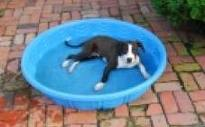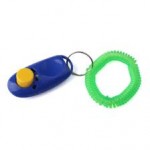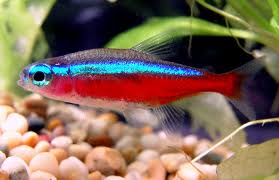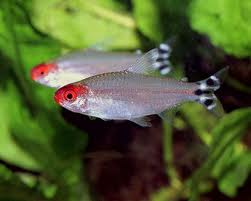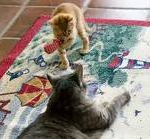 A couple folks have asked me about introducing new cats to their cat family, or even getting a kitten to keep a senior cat company. So I did a little homework because there are lots of myths and incomplete information when it concerns bringing a friend home for your senior cat. An article in Cat Fancy, Company’s Coming did an excellent job and I’ve summarized that article’s pointers in this article.
A couple folks have asked me about introducing new cats to their cat family, or even getting a kitten to keep a senior cat company. So I did a little homework because there are lots of myths and incomplete information when it concerns bringing a friend home for your senior cat. An article in Cat Fancy, Company’s Coming did an excellent job and I’ve summarized that article’s pointers in this article.
There are five ways to introduce a younger female cat (Moolah) to your older, senior male cat (Charlie). Take some time to carefully consider how you do the introduction or you may have more cat fights than cat friendliness going on in your home. You want your older cat to be able to tolerate a new kitten’s antics!
You’ll want to look your home over from Moolah’s curious newcomer’s point of view. Have a child gate or cat carrier to help gradually introduce our two cats. Make sure you or another adult is home during the first few weeks. Be ready for Moolah to be different; her own personality and habits. And, don’t forget the extra food, water dish, and pet litter!
 A checkup with the vet is a good idea for your senior cat, Charlie. For example, if Charlie has feline leukema or feline immunodeficiency virus, then you’ll want to consider Moolah. These two diseases are contagious and can be fatal. If Charlie has endocrine problems, he may have a more aggressive behavior. What if Charlie has arthritis or hearing loss? Moolah may scare or annoy Charlie; an older female cat may be a better fit for Charlie.
A checkup with the vet is a good idea for your senior cat, Charlie. For example, if Charlie has feline leukema or feline immunodeficiency virus, then you’ll want to consider Moolah. These two diseases are contagious and can be fatal. If Charlie has endocrine problems, he may have a more aggressive behavior. What if Charlie has arthritis or hearing loss? Moolah may scare or annoy Charlie; an older female cat may be a better fit for Charlie.
Test Charlie to see if he is up for some companionship. Assuming Charlie is healthy, borrow a friend or neighbor’s healthy cat and let them see each other through a crack in the door. What does Charlie do? Does he hiss and act aggressively or run and hide? If can’t bring a cat in, then try bring another cat’s scent in on a towel or piece of clothing. Again, how does Charlie react? Experts agree that mixing the genders to avoid territory  disputes is a good idea. Getting the opposite sex often works well to avoid these disputes.Also, check for more information from your vet or a cat rescue center.
disputes is a good idea. Getting the opposite sex often works well to avoid these disputes.Also, check for more information from your vet or a cat rescue center.
When you bring Moolah home, keep her separated in a comfortable room. Have the family go in to visit and get to know Moolah. Bring in Charlie’s toys and some of his blankets for his scent. After a few days, let them meet through a gate or crack in the door. Be patient. It could take a week or so, or several months for the cats to feel comfortable with each other.
Moolah, the kitten, is naturally going to demand more attention, so you want to reach out and give Charlie some time, too. Keep the harmony in your home. Feed your cats at the same time, the same way. Play with Moolah but allow Charlie some space. Give Charlie uninterrupted rest and a private place, like a closet or a room.
 Watch for signs of discontent. Signs could include litterbox issues without medical reasons, over-licking, withdrawn, changes in appetite to the point of loosing fur. One of my client’s has just this situation and she consulted her vet for the right procedures, which are working very well. Having patience and being prepared, Moolah has a chance of being happy in her new home with Charlie.
Watch for signs of discontent. Signs could include litterbox issues without medical reasons, over-licking, withdrawn, changes in appetite to the point of loosing fur. One of my client’s has just this situation and she consulted her vet for the right procedures, which are working very well. Having patience and being prepared, Moolah has a chance of being happy in her new home with Charlie.
Don’t confuse hyperthyroidism or hypertension in Charlie as discontent! These conditions should be revealed during Charlie’s visit to the vet. Hyperthyroidism symptons include weight loss, increased appetite, vomiting, diarrhea, and hyperactivity. Hyperactivity in Charlie may explain his restlessness, more vocal, and sudden blindness. Taking Moolah and Charlie to the vet once a year can identify health issues and treatment before they become a problem.

Source: Cat Fancy, Company’s Coming, by Debbie Swanson, page 30, Sept 2011 http://www.catchannel.com/magazines/catfancy/september-2011/introduce-younger-cat-to-senior.aspx

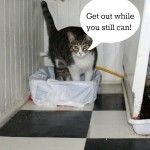






 Most of us do not think of cats having allergies or food intolerance. In
Most of us do not think of cats having allergies or food intolerance. In 

















 If, after all the previous improvements are made and your cat still wants to bolt out the door, consider more formal behavior and clicker training. Using clicker training, you can train your cat to ‘stay’ when the door is opened.
If, after all the previous improvements are made and your cat still wants to bolt out the door, consider more formal behavior and clicker training. Using clicker training, you can train your cat to ‘stay’ when the door is opened.


